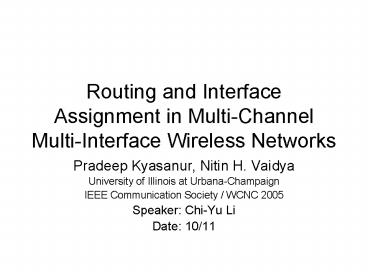Routing and Interface Assignment in MultiChannel MultiInterface Wireless Networks
1 / 17
Title:
Routing and Interface Assignment in MultiChannel MultiInterface Wireless Networks
Description:
Wu et al.[6] and Hung et al.[7] propose a MAC layer solution that requires two ... is used, there is an increase in the end-to-end latency and less connectivity ... –
Number of Views:20
Avg rating:3.0/5.0
Title: Routing and Interface Assignment in MultiChannel MultiInterface Wireless Networks
1
Routing and Interface Assignment in Multi-Channel
Multi-Interface Wireless Networks
- Pradeep Kyasanur, Nitin H. Vaidya
- University of Illinois at Urbana-Champaign
- IEEE Communication Society / WCNC 2005
- Speaker Chi-Yu Li
- Date 10/11
2
Outline
- Introduction
- Related work
- Motivation
- Interface assignment
- Routing strategy
- Discussion
- Conclusion
3
Introduction
- Multiple channels can increase the available
network capacity, but require new protocols to
exploit the available capacity - This paper studies the problem of improving the
capacity of multi-channel wireless networks by
using multiple interfaces - Classify interface assignment strategies
- propose a new interface assignment strategy
- Identify routing heuristics that are suitable for
the proposed interface assignment strategy
4
Related Work
- Nasipuri et al.3,4, and Jain et al.5
propose a class of protocols where all nodes have
an interface on each channel - Wu et al.6 and Hung et al.7 propose a MAC
layer solution that requires two interfaces - So et al.8 propose a MAC solution that uses a
single interface
5
Motivation
- Benefits of using multiple interfaces
- When a single interface is used, there is an
increase in the end-to-end latency and less
connectivity - There is the ability to receive and transmit data
in parallel - Issues with interface switching
- The switching delay will reduce to a few tens of
microseconds
6
Motivation (Cont.)
- Need for specialized routing protocols
- Existing routing protocols for multi-hop networks
such as DSR and AODV may not be suitable for
multi-channel networks
7
Interface Assignment Classification of interface
assignment strategies
- Static Assignment
- Static assignment strategies assign each
interface to a channel either permanently or for
long interval - Common channel approach
- Varying channel approach
- Well-suited for use when the interface switching
delay is large - Nodes that share a channel on one of their
interfaces can directly communicate with each
other
8
Interface Assignment (Cont.) Classification of
interface assignment strategies
- Dynamic Assignment
- Allow any interface to be assigned to any
channel, and interfaces can frequently switch
from one channel to another - The coordination mechanism
- visit a common rendezvous channel periodically
- the use of pseudo-random sequences
- Hybrid Assignment
- Combine static and dynamic assignment strategies
- Allow simplified coordination algorithms
supported by static assignment while retaining
the flexibility of dynamic assignment
9
Interface Assignment (Cont.) A Hybrid Interface
Assignment Strategy
- The interfaces at each node are classified to
fixed interfaces and switchable interfaces - Fixed interface stay on the specified channel
for long durations of time - Switchable interface frequently switch between
any of the remaining channels, based on the data
traffic - A coordination protocol is required to decide
what channel to assign to the fixed interface,
and also for enabling neighbors to know about it - Use some well-known function f of its node
identifier - Explicitly Hello packets
10
Interface Assignment (Cont.) A Hybrid Interface
Assignment Strategy
11
Interface Assignment (Cont.) Supporting
Broadcasts in Multi-Channel networks
- Nodes in a neighborhood may be listening to
different channels - The broadcast packet has to be separately
transmitted on all channels when using multiple
channels - More expensive
- May be sent at slightly different times
- Solution
- At least three interfaces are available, and one
channel can be set apart for broadcast purpose
12
Routing Strategy
- The shortest path metric may not be suitable for
multi-channel, multi-interface networks, because
it doesnt consider the interface switching and
the available channel diversity
CH1
CH1
CH1
CH1
S
D
CH1
CH2
CH3
CH1
S
D
13
Routing StrategyCost of Interface Switching
- Switching delay impacts a node only if the number
of distinct channels is more than that of
available interfaces - Nodes impacted by the switching delay as
interface bottlenecked nodes - The cost of interface switching is measured in
terms of the number of interface bottlenecked
nodes along the route
CH1
CH1
CH2
14
Routing StrategyMeasuring Channel Diversity
- If a node X along a route has i other interfering
nodes receiving on the same channel as X, then
the diversity cost of X is defined to be i - The diversity cost of the whole route is defined
as the maximum diversity cost of any node along
the route
CH1
D
S
CH1
CH1
CH2
15
Routing StrategyRouting Protocol
- Enhanced shortest path metric
- The switching cost the number of interface
bottlenecked links - The diversity cost the max-interference method
- The global resource usage cost the total number
of hops on the route - Routing protocol (based on DSR)
- The destination node sends RREP back for every
RREQ - The source node selects the least cost route by
RREP - Two-phase route discovery process
- Forward the RREQ only on the channel with the
least cost - A full route discovery is invoked, if the RREP
isnt received
16
Discussion
- Impact of Mobility
- The neighbor set frequently changes
- The Hello packet mechanism
- Topology Control
- Distributing nodes across channels, thereby
reducing contention - Integrate with transmission power control
- Other issues
- Selecting the number of interfaces each node
should have depends on the network density,
topology, and the desired cost or performance - Multiple channels may simplify the use of
multi-path routing algorithm
17
Conclusion
- Interface assignment and routing strategy
- Multi-channel Hidden Terminal Problem
A
C
CH1
ACK
A
B
CH1
ACK
B
C
A
C
Switch to CH1
B































